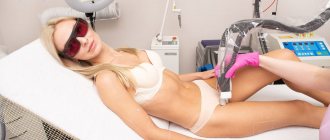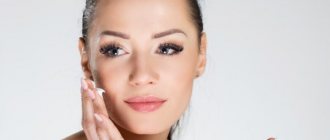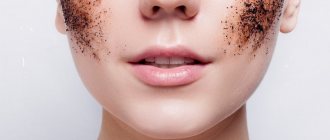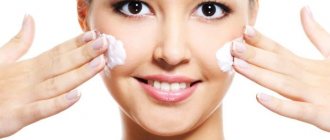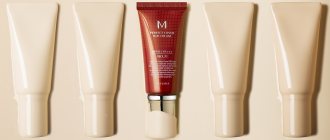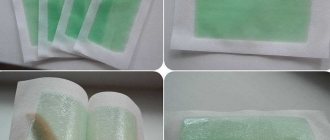Despite the fact that many girls prefer to remove body hair on their own at home rather than in a salon, many still do not know how depilatory cream works. In fact, this method of eliminating unwanted vegetation is considered one of the simplest, but it is important to pay attention to some of the restrictions and precautions that are prescribed for it.
What is depilatory cream for?
Depilatory cream is a special chemical composition that is applied to the treated area and affects the outer length of the hair, destroying it. The product is a superficial method of removing unwanted hair, since hair follicles are practically not affected when used.
Before we figure out how depilatory cream works, let’s consider which areas it can be used on:
- Face (above the upper lip, eyebrows);
- Hands;
- Legs;
- Armpits;
- Classic bikini.
Despite the fact that there is a special cream for intimate depilation, it should be used as carefully as possible. It has a rather aggressive effect on sensitive skin in the treatment area, and if it gets on the mucous membrane it can cause severe irritation.
A depilatory cream is similar to a regular razor, but the effect of its use lasts a little longer - up to 2-4 days, then the hairs begin to gradually grow back.
Rules for using the product
Once you choose the right cream, you can start using it. It is advisable to immediately conduct an allergy test. To do this, apply a very small amount of the product to the arm in the elbow area. After this you need to wait two hours. If the area does not turn red, there is no burning sensation or rash, you can begin depilation.
Using the depilatory cream is very simple, the main thing is to follow the instructions
For the procedure to be as effective as possible, soft scrubs should be used two to three days before depilation to remove dead skin cells. Apply the cream evenly to a clean and dry area (with the exception of creams suitable for use in the shower). The packaging indicates the time after which the cream should be removed. It is not recommended to keep the composition for more than 20 minutes. The result will not be more impressive, and the risk of damaging delicate skin will increase.
Apply the cream using a spatula or sponge according to hair growth. The composition is removed against hair growth. After the procedure, the skin should be treated with cream and oil. Often they come complete with the main product. It is advisable to use a depilator no more than once a week.
Composition of depilatory cream
To find out how a depilatory cream works, let’s pay attention to its composition, since only a few active ingredients contribute to the destruction of the integrity of the hairs and their elimination.
Typically, depilatory cream contains the following three substances:
- Calcium thioglycolate. The main component contained in all depilatory creams, which promotes the destruction of disulfide bonds in the hairs and their detachment from the hair follicles.
- Sodium hydroxide. The bond is a complement to the main active substance, preparing the tissue for it and increasing its permeability.
- Emulsifier ceteareth-20. The substance neutralizes sebum and promotes a more effective effect of calcium thioglycolate.
As a standard, depilatory cream also contains additional components that ensure its pleasant smell, uniform consistency, and also extend shelf life:
- Esters;
- Silicones;
- Plant extracts;
- Oils.
In any case, before using the product, it is important to make sure that it is safe and that there are no toxic or aggressive components in its composition.
Also make sure that there is no individual intolerance to any components of the cream, since an allergic reaction to it can be quite strong.
Advantages and disadvantages
The cream for eliminating unwanted hair has gained popularity among girls due to its many advantages:
- absolute painlessness;
- ease of use;
- absence of bruises after the procedure (which are possible if waxing or sugaring is performed incorrectly);
- You can carry out the procedure at home;
- Depilation does not last long.
Any method of hair removal has its drawbacks, and the use of depilatory cream is no exception. The main disadvantages of this method:
- the effect of use lasts up to 5 days;
- an allergic reaction is possible after the procedure;
- the cream will not be effective enough if the hair is very hard and thick (it may not be completely removed and small “stumps” will remain);
- For regular use, the cream must be purchased in large quantities, which is expensive.
Video: advantages and disadvantages of depilatory creams
The principle of operation of the composition
The main active component of the cream contains alkali, which aggressively affects the structure of the hairs, or rather, their bases, splitting and dissolving them.
While the composition is on the hair, it gradually penetrates the skin, due to which not only its outer part is destroyed, but also 2-3 mm located under the skin. Due to this, the result of such depilation lasts slightly longer than after using a conventional razor.
However, keep in mind that a high concentration of alkali makes the cream not only more effective, but also increases the aggressiveness of its effect on sensitive skin. Because of this, it should be used carefully, following all recommendations and precautions to avoid irritation of the treated area.
Is it possible to permanently remove hair or slow down its growth using depilation?
Depilation does not imply destruction of the hair follicle. Using this method you cannot get rid of hair forever.
Manufacturers write on some products that they contain ingredients that slow down hair growth. The kit may include a cream that needs to be applied to the area after the procedure. It is needed to moisturize the skin, nourish it and slow down hair growth.
The effect of the procedure lasts up to 5 days. The result may differ from what is stated; hairs may begin to appear within a day.
Is there any harm from the cream?
Despite the popularity of depilatory creams, you need to be as careful as possible when using them. It is better to consult with a cosmetologist first so that a specialist can help you choose the optimal composition that will not only be effective and safe for you.
Sometimes depilatory creams cause a skin reaction:
- Irritation;
- Redness;
- Swelling;
- Rash;
- Increased skin sensitivity.
Similar side effects occur when using low-quality or aggressive formulations, individual intolerance to any components of the cream, or non-compliance with recommendations for its use.
The composition has a particularly aggressive effect on the mucous membrane, so it should not be used in areas of increased sensitivity.
In other cases, the cream does not cause much harm, but on the contrary - with its regular use, the hairs gradually become thinner and softer, making it easier to depilate.
Contraindications
Using depilatory cream is a good solution for girls whose hairs are thin and light. The procedure is a salvation for those who are not suitable for sugaring or waxing, but not everyone can use such cosmetics. You need to refuse the procedure if:
- presence of rash, irritation, inflammation, wounds and scratches;
- oncology;
- the presence of neoplasms in the treated area.
During pregnancy, you should choose the most gentle creams
Pregnancy is a conditional contraindication for the use of creams. There is a possibility that a rash may appear on the treated area. You need to clarify in advance whether the composition is suitable for the skin of a pregnant woman, who is highly sensitive.
General tips and recommendations for using the cream
Before performing depilation, it is important to make sure that there is no individual intolerance to the components of the composition. To do this, it is applied to a small area of skin for a few minutes and then washed off. If no signs of irritation appear on the skin within 1-2 hours, you can safely use the cream.
It is quite simple to use - apply a thick layer of the composition to cleansed, damp skin, and after 7-10 minutes, remove it with a special spatula included in the kit. Additionally, you can apply a soothing lotion to your skin.
However, it is important to consider some recommendations when performing depilation with cream:
- Before performing the technique, read the instructions for the cream and make sure there are no contraindications to its use.
- When applying cream, avoid the area around the eyes, as well as mucous membranes when treating the bikini area.
- Wear protective gloves when applying the cream.
- Repeated depilation can be carried out only 5-6 days after the previous one.
- Do not keep the composition on the skin for too long to avoid severe irritation.
If you follow all contraindications and precautions for depilation, you can quickly get rid of unwanted body hair, preventing complications and consequences.
Carrying out the procedure
Before carrying out the depilation procedure, you must take a shower, without using gel or other cosmetics. Dry the skin with a terry towel, after which you can proceed to applying the composition.
How to use depilatory cream correctly:
- apply the cream in a thick layer to your legs or other part of the body with excess hair;
- using a spatula, carefully distribute the product in the direction of hair growth;
- How long to keep the product is indicated in the instructions from the manufacturer - most often the cream should be kept for no more than 5-10 minutes;
- remove any remaining cosmetic product with a spatula, moving it against the hairline;
- rinse off the depilatory cream with plenty of warm water without using soap, gel or other hygiene products.
After the procedure, thoroughly dry the treated areas of the body with a soft towel and apply a softening and restorative agent - cream, gel, lotion.
Advantages and disadvantages of the method
Depilation of unwanted hair using cream has many advantages:
- Simplicity. To perform depilation correctly, a girl does not need any special skills, the main thing is to follow the recommendations prescribed by the cosmetologist;
- Speed. Usually the procedure does not take more than 10-15 minutes, during which you can achieve ideal smoothness of the skin without any problems;
- Effect. Unlike a razor, after depilatory cream, the skin in the treatment area remains perfectly smooth and velvety, there are no missing hairs;
- Painless. While using the cream, the girl feels absolutely no sensations.
Also, if the procedure is performed correctly, the depilatory cream does not cause irritation and does not damage the skin.
However, keep in mind some of the disadvantages of the technology:
- Low long-term retention of results. Since only the length of hair is removed, and the hair follicles are not affected, they begin to grow back within 2-3 days after depilation;
- Risks of allergic reaction and skin irritation. When using low-quality products or their careless application, side effects may occur;
- Creams are not universal. They do not cope well with coarse, dark and short hairs;
- Price. The cost of one package of cream can reach 300 rubles, and it is usually enough for 3-4 zones.
In any case, many girls now use depilatory creams to achieve perfectly smooth skin at home. Despite some disadvantages, they do their job well and remove unwanted hair from the body.
How to choose the right cosmetic product?
Which cream is the most effective? What is best to use during pregnancy? To choose the right cosmetic product for hair removal, you need to carefully study its composition and instructions for use. Armpit depilatory cream should not be used to remove hair from the bikini area, arms or legs.
This is due to the fact that in these areas of the body the hair has different stiffness. Therefore, a delicate facial depilatory cream will be ineffective if applied to inappropriate areas. At the same time, using a product to remove coarse hair on delicate parts of the body can cause severe irritation. In this situation, you should make sure that the composition of the drug is suitable for sensitive skin. But is it possible to do depilation during pregnancy and how such a procedure is carried out is indicated here.
Video on how to choose depilatory cream:
The depilatory cream must have a normal shelf life. Under no circumstances should a stitched product be used. No one can guarantee that it will not have a negative effect on human skin. An allergic reaction and even inflammation may occur.
When choosing a depilatory cream during pregnancy, you should pay attention to popular manufacturers. Their price is much higher than that of lesser-known competitors, but they are responsible for the quality of all components and guarantee complete safety of use.
You may also be interested in information about how deep bikini depilation is carried out and how you can carry out such a procedure with your own hands.
Negative consequences
After incorrect depilation using cream, the following consequences may occur:
- Burns. Most often they appear due to the fact that the cream has been overexposed. In this case, it is necessary to rinse the burn with cool water and apply a healing cream. If your skin condition has not improved after a few days, consult a dermatologist.
- Ingrown hair. You can reduce the likelihood of this consequence occurring. To do this, peel the area to be depilated the day before the main procedure, and immediately before the session, take a bath. If ingrown hairs have already appeared, steam them with a hot towel and apply a scrub. This must be done 2–4 times (no more than one session per day).
- Allergy. In this case, stop using the cream immediately. If irritation persists, consult a doctor.
To avoid this, follow the instructions for use of the product and take precautions.
Precautionary measures
To avoid unpleasant consequences of using depilatory cream, follow these precautions:
- Strictly follow the recommendations on the packaging. Often people do not pay attention to the included instructions. But it is necessary to do this, since the latter describes the nuances regarding the product you purchased.
- Do not use expired cream. Using such a tool will lead to unpredictable results.
- Do not apply the product to irritated or inflamed skin. The same applies to the presence of moles, scars, fresh tans and microcracks on the treated surface.
- If you have hormonal diseases, diabetes and excessive dry skin, consult your doctor before using the cream.
- For the first day after the session, wear loose clothing made from natural material.
- For 24 hours after the procedure, do not swim, do not sunbathe, do not use deodorants and antiperspirants, as well as perfumes and decorative cosmetics.
- Do not shave or reuse depilatory cream for three days after completing the procedure.
Etiology and pathogenesis
The hormonal level and structural features of the hair follicle determine the condition of the hair - its length, thickness, crimp, growth rate, localization, etc.
After birth, thin and weakly pigmented hair gradually begins to grow on the child’s body - they are called vellus (vellus). Their diameter does not exceed 30 microns, their length is less than 2 cm. Vellus hair is devoid of medulla and the muscle that lifts the hair, and its bulb is located at the level of the reticular layer of the dermis. In adults, vellus is present on the scalp - for example, in the frontoparietal zone (here the norm is 20% of vellus hair).
As we grow older, androgens are activated in the body, which contribute to the transformation of vellus hair into terminal hair (larger and more pigmented). The degree of transformation is influenced by the level and duration of androgenic effects, local activity of 5-alpha reductase in the area of hair follicles and their sensitivity to hormonal influences. At the same time, vellus hair remains in some areas of the body, which is normal (parietal area of the head, eyebrows, eyelashes).
In its development, hair goes through three phases - anagen (growth), catagen (transition to rest) and telogen (rest):
- In anagen, the hair actively grows, its bulb takes on a complete shape.
- In catagen, atrophy of the hair follicle begins to develop.
- In telogen, the hair shaft breaks away from the follicle and falls out over time, and young hair begins to mature near the follicle.
The main hormone to which the hair follicle reacts is dihydrotestosterone. It is not only present in human blood, but is also synthesized in the bulb area from its precursor, testosterone. Local production of dihydrotestosterone is determined by the activity of 5-alpha reductase in the skin. Differences in the activity of this enzyme are a criterion for why women with the same plasma testosterone levels may have varying degrees of hirsutism or no hirsutism at all.
The main causes of hirsutism:
- Polycystic ovary syndrome (PCOS) is the most common cause of hirsutism. PCOS is characterized by an imbalance of sex hormones, which leads to menstrual irregularities, obesity, multiple ovarian cysts and infertility.
- Cushing's syndrome occurs when there are high levels of cortisol in the blood. Its cause is either excess production of this hormone by the adrenal glands, or long-term use of certain medications (for example, glucocorticoids).
- Congenital adrenal hyperplasia is a hereditary pathology in which the adrenal glands synthesize large amounts of steroid hormones, including cortisol and androgens.
- Tumors are an uncommon but possible cause of hirsutism. The disease is usually caused by androgen-secreting tumors of the ovaries or adrenal glands.
- Medications —hirsutism can be caused by taking certain medications (synthetic androgens, systemic corticosteroids, a number of antidepressants).
Sometimes the disease occurs for no apparent reason - this is idiopathic hirsutism. It is a diagnosis of exclusion, i.e. it is diagnosed when all other possible causes of the disease are excluded. Most often, idiopathic hirsutism is recorded in women from the Middle Eastern, Mediterranean and South Asian regions.
Risk factors for hirsutism:
- Family history - it is worth paying attention not to cases of excess hair growth in the family, but to hormonal diseases in close relatives. Particular attention is paid to the presence of PCOS and adrenal hyperplasia.
- Origin - as mentioned above, women from the Middle Eastern, Mediterranean and South Asian regions experience hirsutism more often.
- Obesity increases the production of androgens, which increases the likelihood of hirsutism.

